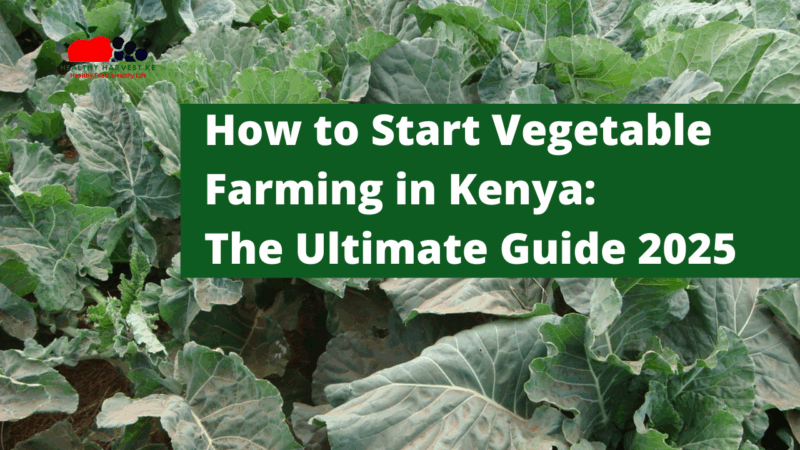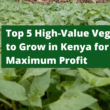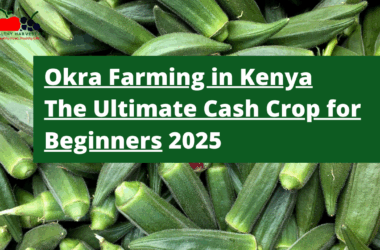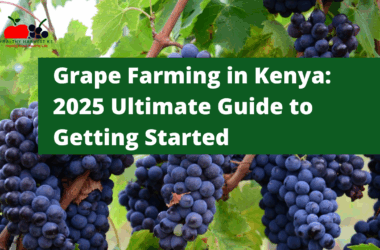So you’re thinking about jumping into vegetable farming in Kenya? Smart move. What locals call “green gold” isn’t just a catchy phrase – it’s the reality for thousands of farmers turning small plots into serious income generators.
In this guide, I’ll walk you through everything you need to know to start your own vegetable farm in Kenya – from choosing the right crops to understanding the market dynamics that’ll determine your success. No fluff, just practical advice you can actually use.
Why Vegetable Farming in Kenya Makes Sense Right Now
Kenya’s vegetable production is on a steady climb, expected to reach 3.1 million metric tons by 2028 from 2.95 million in 2023. That’s a solid 1% annual growth that shows this sector isn’t just surviving – it’s thriving.
But the real appeal? Return on investment. Many Kenyan farmers call vegetable cultivation “green gold,” highlighting its potential for substantial returns on relatively small land areas. While two-thirds of smallholder farmers earn less than Ksh 7,740 monthly, vegetable farmers often break this ceiling easily.
Take Brian Owade, a 27-year-old who discovered vegetable farming by chance. Despite limited land, he found vegetables provided excellent returns from small plots, with a single sack selling for Sh3,000 – equivalent to a month’s worth of cattle feed.
Choosing Your Vegetables: What Grows Best Where
Kenya’s diverse climate supports an impressive range of vegetables. Your first step is matching what you grow to your specific location:
Top Performing Vegetables in Kenya
Kale (Sukuma Wiki)
- Best growing season: March-August or September-January
- Market price: Approximately Ksh 24/kg
- Growing notes: Thrives in cooler weather, nutritional powerhouse containing vitamins A, C, calcium, and iron
Spinach
- Temperature sweet spot: 15-27°C
- Growing notes: Can be propagated from seeds or cuttings, needs regular watering
- Value proposition: High iron content makes it nutritionally valuable
Tomatoes
- Market price: Approximately Ksh 100/kg
- Growing notes: Among the most versatile vegetables, requires well-drained, nutrient-rich soils
Onions
- Best planting time: Cool, dry months (March-August)
- Market price: Approximately Ksh 85/kg
- Growing notes: Needs loose, well-drained soil and plenty of sunlight
Carrots
- Best planting time: May-September
- Market price: Approximately Ksh 32/kg
- Growing notes: Thrives in well-drained soil enriched with organic matter and compost
Indigenous Vegetables
- Market value: African nightshade (managu) sells for approximately Sh50 per kilogram or Sh1,800 per sack
- Growing notes: Often more pest-resistant than exotic varieties, well-adapted to local conditions
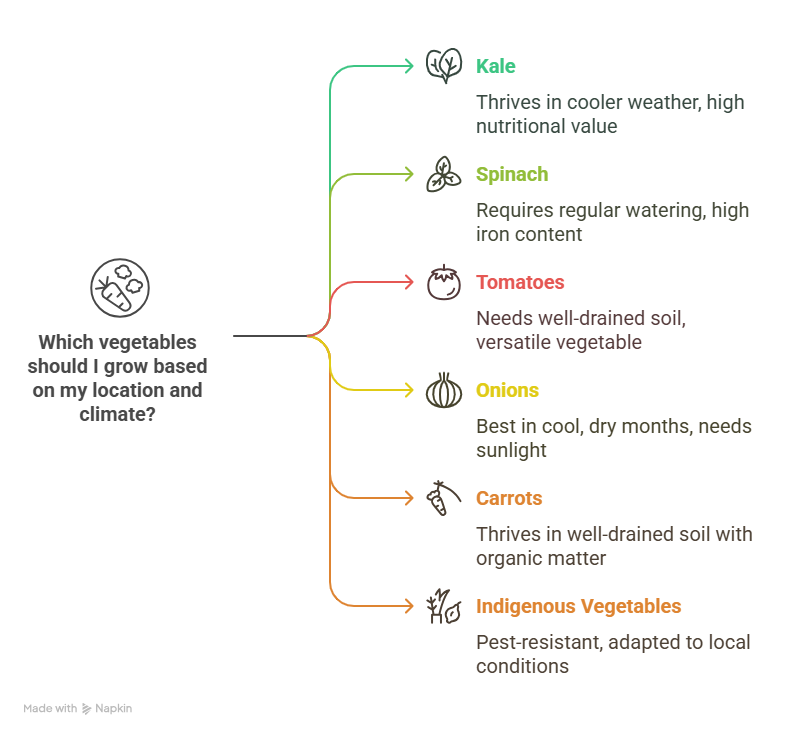
Regional Growing Considerations
Your location in Kenya significantly impacts what you should grow:
Coastal Areas The warm, humid climate favors heat-loving vegetables like capsicum, eggplant, okra, pumpkin, sweet potatoes, and cassava, according to practical farming guides.
Central Highlands With their temperate climate, these regions are ideal for growing maize, beans, cabbages, carrots, and tomatoes, as noted by Rich Farm Kenya.
Northern Kenya Despite the arid conditions, vegetables like sunflowers, kale, and collards can thrive with proper management, based on regional farming research.
Setting Up Your Farm: The Practical Steps
Now let’s get into the nitty-gritty of how to actually set up your vegetable farm:
Land Requirements
One of the beauties of vegetable farming is its efficiency. You don’t need massive acreage to start making money. Many successful Kenyan vegetable farmers work with plots smaller than an acre.
Consider these factors when choosing your land:
- Water access (consistent irrigation is crucial)
- Soil type (most vegetables prefer well-drained, loamy soil)
- Sunlight exposure (6-8 hours daily is ideal for most vegetables)
- Protection from strong winds
Soil Preparation Techniques
Soil preparation is where your success begins:
- Testing: Before anything else, get your soil tested. This costs between Ksh 2,500 and Ksh 5,000 but is worth every shilling. You’ll know exactly what your soil needs.
- Clearing and tilling: Remove all weeds and rocks, then till the soil to improve aeration.
- Adding organic matter: Incorporate compost or well-rotted manure to improve soil structure and fertility.
- pH adjustment: Most vegetables prefer slightly acidic to neutral soil (pH 6.0-7.0). Add lime to raise pH or sulfur to lower it based on your test results.
Organic Farming Methods That Work in Kenya
Organic farming isn’t just better for the environment – it can be more profitable too. Here’s how to do it right:
Effective Composting
Composting transforms organic waste into gold for your soil:
- Mix green materials (vegetable scraps, fresh grass clippings) with brown materials (dry leaves, straw) in roughly equal proportions
- Keep your compost pile slightly moist but not soggy
- Turn it regularly to provide oxygen
- Ready compost will be dark, crumbly, and earthy-smelling
Crop Rotation Strategies
Don’t plant the same crops in the same place year after year. Instead, follow these family rotations:
- Leafy greens (kale, spinach)
- Fruiting vegetables (tomatoes, peppers)
- Root crops (carrots, onions)
- Legumes (beans, peas)
This practice prevents soil nutrient depletion, reduces pest infestations by disrupting their life cycles, and improves overall soil quality and crop yields.
Natural Pest Management for Kenyan Conditions
Forget expensive and harmful chemical pesticides. These natural methods work brilliantly:
Companion Planting
Some plants naturally repel pests that would otherwise attack your vegetables:
- Plant marigolds around your garden to repel nematodes and other soil pests
- Grow onions or garlic near carrots to repel carrot flies
- Surround your cabbage family plants with aromatic herbs like rosemary, sage, or mint to confuse cabbage moths
Homemade Organic Pesticides
These DIY solutions are effective and safe:
- Mix 1 tablespoon neem oil with 1 teaspoon liquid soap and 1 liter of water
- Spray directly on affected plants weekly
Garlic Spray
- Blend 4-5 garlic cloves with 2 cups water
- Strain and dilute with another 2 cups of water
- Add 1 tablespoon of mild liquid soap
- Spray on plants to repel aphids, spider mites, and various caterpillars
Irrigation and Water Management Techniques
In Kenya’s increasingly unpredictable climate, smart water management is essential:
Drip Irrigation
This system delivers water directly to plant roots, reducing waste:
- Initial setup costs between Ksh 15,000-25,000 per acre
- Reduces water usage by up to 60% compared to overhead sprinklers
- Minimizes fungal diseases by keeping foliage dry
- Can be combined with timers for automated watering
Water Conservation Practices
Even without fancy systems, you can conserve water:
- Apply mulch around plants to reduce evaporation
- Water early morning or evening to minimize evaporation
- Collect rainwater in storage tanks during rainy seasons
- Consider constructing water pans for larger operations
Harvesting and Post-Harvest Handling
Proper harvesting and handling can make the difference between premium prices and wasted crops:
Optimal Harvesting Times
- Leafy greens: Early morning when leaves are crisp and temperatures are cool
- Root vegetables: When they reach marketable size but before they become woody
- Tomatoes: When they begin showing color change but before fully ripe (they’ll continue ripening after harvest)
Reducing Post-Harvest Losses
Post-harvest losses can eat up to 30% of your profits if you’re not careful:
- Wash vegetables in clean, chlorinated water (1 tablespoon bleach per gallon)
- Remove field heat by keeping harvested vegetables in shade immediately
- Use clean, ventilated crates for transportation, not sacks that crush produce
- Grade your produce based on size and quality to maximize returns
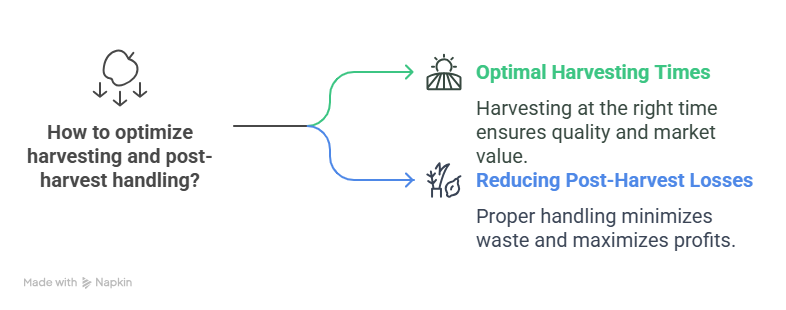
Marketing Your Vegetable Produce
Growing great vegetables is only half the battle – selling them at good prices is equally important:
Understanding Current Market Prices
Recent data from Nairobi markets shows considerable price variation:
- Cabbages: Ksh 15/kg
- Kales: Ksh 24/kg
- Carrots: Ksh 32/kg
- Cucumber: Ksh 45/kg
- Capsicums: Ksh 60/kg
- Lettuce: Ksh 65/kg
- Tomatoes: Ksh 100/kg
Indigenous vegetables often command premium prices, with African nightshade (managu) selling for approximately Sh50 per kilogram or Sh1,800 per sack.
Direct Marketing Strategies
Cutting out middlemen can dramatically increase your profits:
- Sell directly at local markets (get necessary permits first)
- Establish relationships with restaurants, hotels, and schools
- Consider subscription vegetable boxes delivered weekly to urban customers
- Use social media to connect with health-conscious urban buyers
Navigating New Regulations
Kenya’s vegetable farming sector faces potentially transformative regulatory changes that you need to be aware of:
Upcoming Certification Requirements
The government intends to implement stricter farm regulations:
- Mandatory KS1758 Kenyan standard certification, introducing over 500 new regulations
- National Environment Management Authority (NEMA) licenses costing a minimum of Ksh 10,000
- Mandatory soil and water analyses costing between Ksh 2,500 and Ksh 5,000
- Extensive record-keeping, including nutrient analysis of compost or manure used
While these requirements aim to improve food safety, they could present challenges for smallholder farmers. Staying informed and preparing for these changes now will help you avoid disruptions later.
Success Stories: Learning From Kenya’s Vegetable Farming Stars
Real examples show what’s possible when you get vegetable farming right:
Frederick Atsiaya This 41-year-old former dairy technologist from Vihiga County made the “hard decision” to switch to vegetable farming. The result? He tripled his income and now supports six children through his vegetable farming operations.
Timothy Ingatia Starting vegetable farming while still in primary school, Timothy used his earnings to help pay school fees. After an unsuccessful job search in Mombasa, he returned to farming and now harvests multiple sacks of indigenous vegetables weekly, earning enough to support his siblings’ education.
These stories highlight how vegetable farming serves as an accessible entry point to agricultural entrepreneurship, particularly for youth and those with limited education or formal employment options.
Climate-Smart Agriculture for Future Success
Climate change poses real threats to Kenya’s vegetable production through increased weather variability, shifting pest patterns, and water scarcity. Get ahead with these practices:
Innovative Approaches Working in Kenya
Reduced Tillage Minimizing soil disturbance helps maintain soil structure and organic matter, improving resilience during extreme weather events.
Diversification Growing multiple vegetable varieties provides insurance against crop-specific climate impacts and stabilizes income streams.
Modern Technology Adoption Take advantage of training initiatives like those in Nakuru County, which has partnered with international organizations to provide training in cutting-edge agricultural technologies that enhance vegetable farming practices while building climate resilience.
Starting Your Vegetable Farm: The Action Plan
Now that you understand the landscape, here’s your step-by-step plan to launch your vegetable farming business:
- Research and site selection (1-2 months)
- Identify your target market and what vegetables are in demand
- Select appropriate land with good access to water
- Conduct soil tests
- Farm setup (2-4 weeks)
- Prepare soil and create growing beds
- Install irrigation systems
- Source high-quality seeds or seedlings
- Planting and growing (varies by crop)
- Follow recommended spacing and planting depths
- Implement your organic pest management plan
- Maintain regular watering schedule
- Establish market connections (ongoing)
- Contact potential buyers before harvest
- Prepare proper packaging materials
- Set up reliable transportation
- Harvest and sell (ongoing)
- Harvest at optimal times for each vegetable
- Grade produce for different market segments
- Keep detailed records of sales and expenses

Conclusion: Your Vegetable Farming Journey
Vegetable farming in Kenya represents a vital sector with significant potential for enhancing food security, improving nutrition, and providing economic opportunities. The sector’s capacity to generate substantial returns from small land areas makes it particularly valuable in a country with growing population pressure and decreasing farm sizes.
The experiences of successful vegetable farmers across Kenya demonstrate the sector’s transformative potential when farmers receive appropriate support, training, and market access. As Kenya moves toward 2028 and beyond, vegetable farming will likely continue its growth trajectory while evolving to meet changing consumer demands, regulatory requirements, and environmental conditions.
Your timing couldn’t be better – with the right approach, vegetable farming in Kenya can transform not just your finances, but your entire life.
Ready to get your hands dirty?




